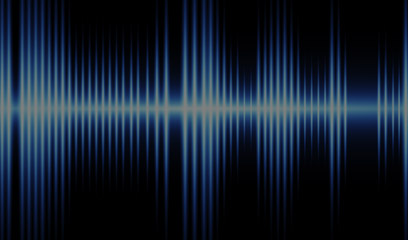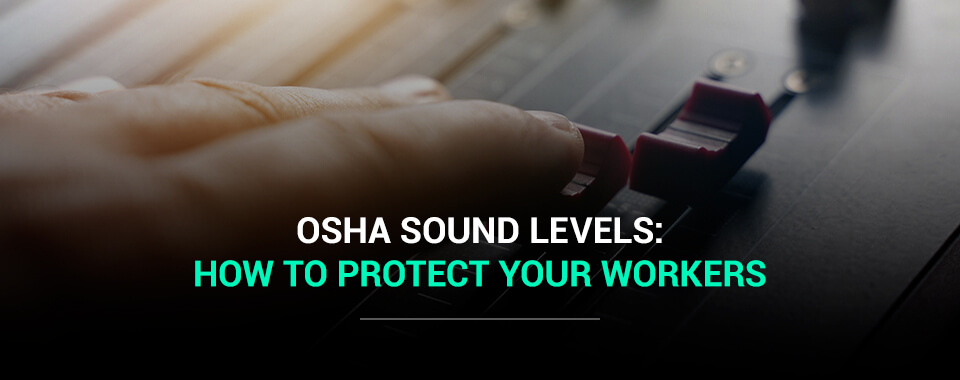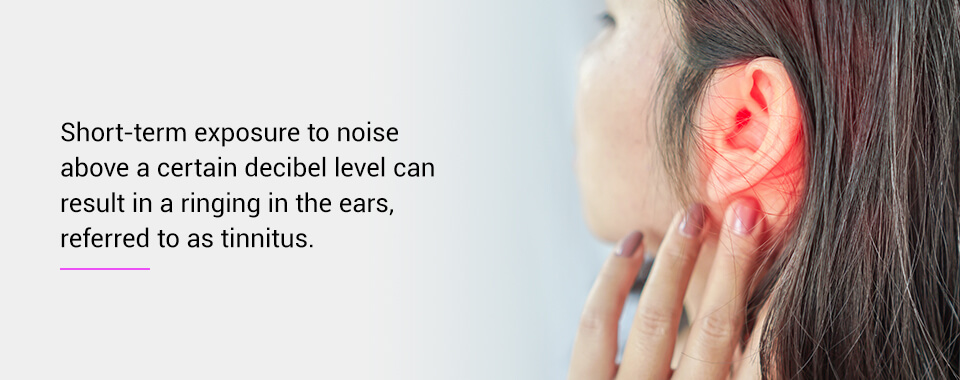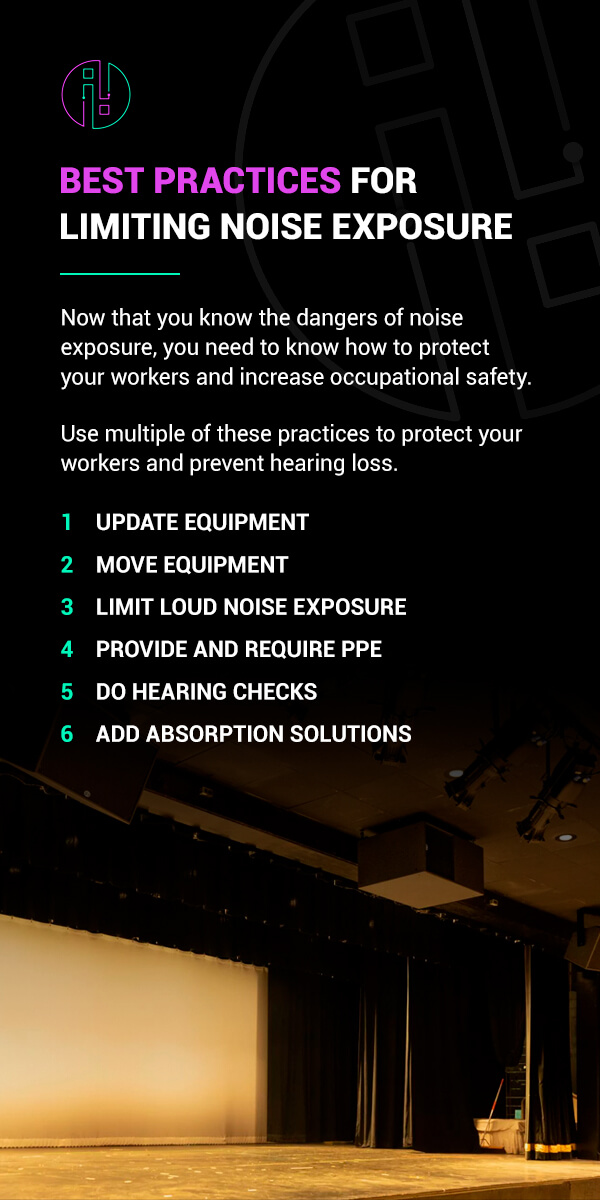

There’s no denying that noise is a common problem in many industries, with workplaces often averaging over the safe limit of sound. As a result, hearing loss is the most common work-related injury in the United States, classified under exposure to harmful substances or environments. When noises are too loud, employees can endure damaged hearing, increased levels of stress and more.
Take a look at why it’s critical to protect your workers from periods of noise exposure of different levels and how to do so.
The human ear perceives sound when air molecules vibrate and enter the ear canal, moving the microscopic hairs within the inner ear. Sound can be measured in a number of ways, including frequency, wavelength and sound pressure.
The vibrations can be measured to find the frequency of the sound. The frequency, measured in Hertz, is the number of vibrations that occur in one second. We often refer to the frequency of a sound as its pitch, or how high or low something sounds.
The wavelength is the distance a sound wave travels during one vibration. It’s typically measured in feet or meters and has a direct relationship with frequency. The shorter the wave, the higher the pitch. The longer the wave, the lower the pitch.
Sound is also measured in decibels, which refers to sound pressure. The higher the number of decibels, the more intense the noise. The more intense the noise, the more likely it is for your hearing to be impaired. When the vibrations of the air molecules are too intense, the microscopic hairs in your inner ear can be damaged. This is why loud sounds are dangerous.
High sound levels can result in permanent health effects, especially if they occur over long periods of time or on a consistent basis. This is why loud noises in the workplace are particularly damaging, and why legal limits for noise exist.
Employees have to show up to work, and they often can’t go anywhere else during the workday to escape the noise. Workers can experience numerous effects of noise exposure, including temporary and permanent hearing loss, increased physical and psychological stress, workplace accidents and more. Your business may also suffer from noise violations and unsatisfied employees.

Most notably, loud noises can lead to temporary and permanent hearing loss. Short-term exposure to noise above a certain decibel level can result in a ringing in the ears, referred to as tinnitus. Your hearing may become slightly impaired and your ears may feel like they’re stuffed up. These temporary problems can last for minutes or hours after getting out of range of the noise.
Repeated exposure to loud noises can make these temporary problems turn into permanent ones. The ringing in the ear may never go away, or there could be partial or complete hearing loss. This is because the vibration of the sound is so strong that, over time, it damages the inner ear.
Occupational noise exposure can lead to hyperacusis and diplacusis. Hyperacusis is a disorder where you become overly sensitive to a range of sounds because they sound louder than normal. Sounds within safe limits can still cause pain. Diplacusis is a form of hearing loss that results in “double hearing,” where you perceive one sound as two.
The stress of being in loud environments may affect more than just your ears.
Consistent exposure to unsuitable levels of noise has been linked to high blood pressure, high cholesterol and increased heart rate. These issues continue even after leaving the noise. Additionally, researchers have found that certain decibel increases in noise levels are linked to a 34% increase in heart attacks, strokes, and other heart-related issues.
High noise levels in the workplace can lead to more accidents. Other than accidents that may be caused by the issues stated above, high levels of sound may cover up important alarms or notifications.
Many workplaces are equipped with warning signals to let everyone know that a door is open, a machine is on, equipment is malfunctioning and a number of other events. Workplaces with noises loud enough to impair someone’s hearing will contribute to accidents when workers can’t hear the alarm.
Exceeding the legal limit of noise can result in a noise violation for your business. The Occupational Safety and Health Administration (OSHA) requires employers with noise exposure at or above 85 decibels to implement a special hearing conservation program to protect workers. You must provide free annual hearing exams, hearing protection, training and evaluations.
In addition to the above, loud sound levels in the workplace simply leads to unhappy workers. The level of noise can be uncomfortable and distracting, and people may worry more about their health. Noise levels that are too high are common complaints employees have with their workplaces. Unhappy workers could mean less productivity for your business as a result.

OSHA has determined the highest average permissible level of noise for the amount of time of exposure. The permissible exposure limit for an eight-hour workday is 90 decibels. If the average noise level goes up to 95 decibels, the permissible exposure limit changes by only 5 decibels. But how loud is the difference between 90 and 95 decibels?
Since decibels are measured logarithmically, a small change in the decibel level actually indicates a much larger change in noise level. The acceptable range of sound goes from zero to 70 decibels.
Consider that 60 decibels is the noise level of having a conversation with someone 3 feet away. But when it goes up to 70 decibels, it’s multiple conversations happening at once, such as classroom chatter. After it goes up another 10 decibels, it’s getting close to the warning level.
Just five more decibels and OSHA requires you to have a hearing conservation program. Hearing conservation programs require employers to monitor and test employees’ hearing if they’re exposed to decibels of 85 or higher. These programs are also responsible for educating and training employees on noise level safety and when, where and how to properly wear hearing protection.
When the noise level gets to 90 decibels, it’s as loud as a boiler room. This is the maximum average noise level for employees working eight-hour shifts. At the next level, 100 decibels, it’s as loud as a construction site. Employees can only work at this level of noise for two hours.
At 110 decibels, it’s like being in a nightclub with loud music. It may not seem like that would be enough to damage your hearing, but OSHA only recommends being exposed to this level of noise for less than 15 minutes. Then, 120 decibels is the noise level of operating heavy equipment. No one should be exposed to this much noise for any period of time, so hearing protection devices are strongly recommended.
At 130 decibels, it sounds like a jet taking off from 200 feet away. The next level, 140 decibels, is when someone starts feeling physical pain. Even though there isn’t pain until this level, that doesn’t mean the lower levels are safe. At this point, there could be severe and permanent damage.
There are many industries where daily noise exposure is a common problem. Much of the noise comes from machinery or engines, so workplaces like construction sites and railways are particularly loud. Workers who are employed in these industries should be aware of the risks to their hearing and know about hearing damage protection.
Construction workers experience a variety of loud noises on a regular basis. There are bulldozers, trucks, jackhammers, drills and more operating at the same time and causing a lot of noise. Noise levels can reach as high as 120 decibels and often stay above 85 decibels throughout the workday.
Jets taking off generate at least 130 decibels of noise from 200 feet away, and can be as loud as 190 decibels. This means airline workers, like aircraft maintenance crews, baggage handlers and other airline employees regularly work near noises exceeding the safe limits.
Miners are also exposed to loud noises in their work. In fact, noise levels range from 93 to 106 decibels for most of the day. There are jackhammers, drilling machines and more running at the same time. While noise isn’t the only occupational hazard for miners, it’s still important to try to avoid it.
Manufacturing plants constantly have loud machinery running. There are all kinds of machines that produce extremely loud noises, and workers in close proximity to these machines are at risk of hearing damage. Whether workers are on a production line, performing equipment maintenance or supervising the operation, they should be cautious when exposed to consistently high noise levels.
Railway workers who maintain trains and tracks regularly are exposed to loud sounds during their routines. When trains go by, noise levels can reach as high as 140 decibels. While the noise doesn’t last for long, it can still affect hearing over time.

Now that you know the dangers of noise exposure, you need to know how to protect your workers and increase occupational safety. There are many ways to limit noise exposure, and you should never depend on just one. Use multiple of these practices to protect your workers and prevent hearing loss.
Older equipment is often much louder, typically from years of wear. If your equipment is what’s causing the noise level to be too high, updating it may be the answer. Buying a tool just 3 decibels quieter cuts the noise energy in half. Buy Quiet is a prevention initiative that provides information on equipment noise levels and can help companies find quieter products.
Quieter equipment is the best way to protect workers. It won’t cover up communication, alarms or other necessary sounds. It’s also cost-effective, as buying quieter equipment will help to reduce hearing-related work injuries for which your company would have to pay workers’ compensation.
Design work areas that separate noisy equipment from other spaces. This may mean moving equipment, adding sound barriers or reworking the entire workplace. If two loud machines are operating right next to each other, the environment is going to be much noisier than it should be.
You may also need to move noisy equipment away from common areas, so only the people who need to work in that area and are trained in how to protect their hearing are exposed to the noise.
Another way to protect your workers is to limit their exposure to loud noise. One way to do this would be to have employees work in different areas during their shifts. For example, instead of working eight hours in a noisy area, schedule team members to work half their shift in the noisy area and half in a quieter one. Allowing employees to take breaks in a quiet space also helps limit their exposure to unsafe noise.
Personal protective equipment (PPE) is an effective measure to take but should never be the only measure. Hearing protection, such as noise-reducing headphones or earplugs, can help limit the risk of hearing damage by reducing the amount of noise that reaches the ear.
There are two types of hearing PPE — earplugs and earmuffs:
However, PPE can become damaged and less effective. Workers may also not use it, either because they forget or because they think they don’t need it. It also makes it difficult for people to hear instructions, alarms or other warnings and must be compatible with any other PPE your workers need to wear, such as hard hats or safety goggles.
Hearing checks are often required in any business that exposes its workers to high noise levels. All new employees should have their hearing checked so you can collect baseline hearing information and can monitor their hearing throughout their time with your company. Hearing checks should be conducted at least every two years.
Acoustic solutions can help reduce noise in almost any workplace. These treatments help by either absorbing the sound or diffusing it. For example, acoustic panels are designed to absorb sound and keep it from reverberating in the space. These are typically installed on the walls of the space, but there are also panels that can be hung from the ceiling. They actually remove sound from the space and make it quieter.
If you need even more soundproofing, fiberglass is a great option. While it’s not as easy as simply installing something on a wall or hanging it from the ceiling, it prevents sound from moving from one space to another. Note that fiberglass is installed inside the walls, so it may not be the best solution in large, open spaces.
A quality acoustic system can help reduce noise and protect your workers’ ears. Illuminated Integration offers acoustic services all the way from design to installation. We’ll consult with you to fully understand your needs and ideas, and then we’ll begin developing them in our 3D rendering programs.
Our experts will provide you with an initial draft of the acoustics plan and review the design with you. Then, we’ll fully implement and install the acoustics system. This means you’ll have a seamless experience while getting the solutions you need.
A noisy environment will damage your workers’ ears and harm your business. Contact Illuminated Integration today to learn more about how we can help you reduce noise in the workplace.